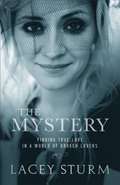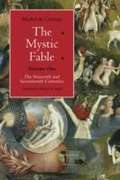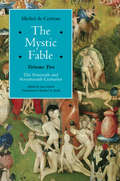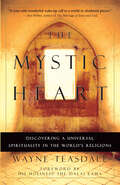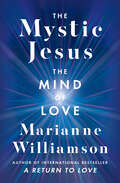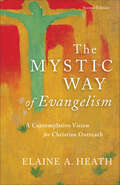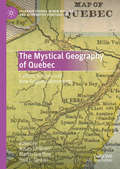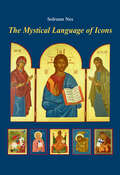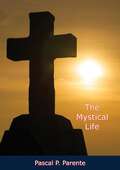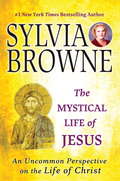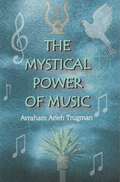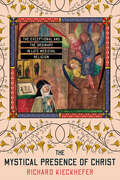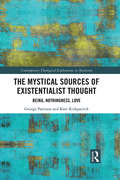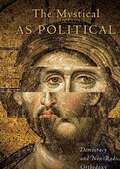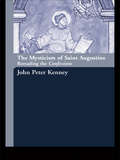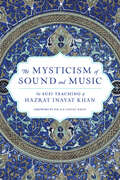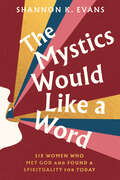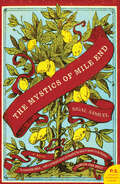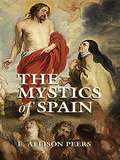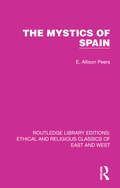- Table View
- List View
The Mystery: Finding True Love in a World of Broken Lovers
by Lacey SturmLacey Sturm wants to share her journey from heartbreak to wholeness with young women. In The Mystery, Sturm helps readers understand that any loving relationship begins with knowing your own identity in Christ.
The Mystic Fable, Volume 1: The Sixteenth And Seventeenth Centuries
by Michel De Certeau Michael B. SmithThe culmination of de Certeau's lifelong engagement with the human sciences, this volume is both an analysis of Christian mysticism during the sixteenth and seventeenth centuries and an application of this influential scholar's transdisciplinary historiography.
The Mystic Fable, Volume Two
by Michel De Certeau Michael B. Smith Luce GiardMore than two decades have passed since Chicago published the first volume of this groundbreaking work in the Religion and Postmodernism series. It quickly became influential across a wide range of disciplines and helped to make the tools of poststructuralist thought available to religious studies and theology, especially in the areas of late medieval and early modern mysticism. Though the second volume remained in fragments at the time of his death, Michel de Certeau had the foresight to leave his literary executor detailed instructions for its completion, which formed the basis for the present work. Together, both volumes solidify Certeau's place as a touchstone of twentieth-century literature and philosophy, and continue his exploration of the paradoxes of historiography; the construction of social reality through practice, testimony, and belief; the theorization of speech in angelology and glossolalia; and the interplay of prose and poetry in discourses of the ineffable. This book will be of vital interest to scholars in religious studies, theology, philosophy, history, and literature.
The Mystic Heart: Discovering a Universal Spirituality in the World's Religions
by Wayne TeasdaleDrawing on experience as an interreligious monk, Brother Wayne Teasdale reveals the power of spirituality and its practical elements. He combines a profound Christian faith with an intimate understanding of ancient religious traditions.
The Mystic Jesus: The Mind of Love (The Marianne Williamson Series)
by Marianne WilliamsonReturning to the topic of her beloved classic bestseller A Return to Love, spiritual guide Marianne Williamson builds on the ideas introduced in that book to lead us toward the light through the inspiring guidance of the mystic Jesus.In A Return to Love: Reflections on the Principles of A Course in Miracles, Marianne Williamson revealed how we each become miracle-workers when expressing love and forgiveness in our everyday lives. With The Mystic Jesus, Williamson reveals the role of Jesus in the teachings of the Course. For many, Jesus has become a precious relic, revered yet lacking the immediacy of authentic spiritual force. In The Mystic Jesus, Williamson writes of a Jesus who transcends both glib imagery and outdated religious dogma. She writes not only of an historical Messiah but of a spirit alive in all of us today.Williamson brings to The Mystic Jesus her talent at making the densest theological theories relevant to our everyday lives. She merges psychological and religious understanding, presenting Jesus as a guide to another way of thinking, therefore the builder of another kind of world. The Jesus in The Mystic Jesus truly is, in the words of St. Augustine, “ever ancient, ever new.”The Jesus presented here is a radical love, an ever-present teacher, an evolutionary elder brother, and a savior from the fear-based, twisted thinking that dominates our world. The Mystic Jesus is both theological and practical, signature Williamson in both its intellectual clarity and emotional impact.
The Mystic Rose
by Stephen R. LawheadStephen R. Lawhead's Celtic Crusades saga has won widespread critical acclaim and a legion of loyal readers. Now, he returns with the final volume in this magnificent series -- a tale rich in history and imagination, filled with danger, betrayal, courage, and faith, as the third generation of a Scottish noble family continues its eternal quest to secure the divine on earth, and preserve humankind's last true hope for salvation.While undergoing the initiation into the highest order of a secret religious society, Scottish lawyer Gordon Murray discovers the greatest revelation of all ...A thousand years after its disappearance, the Mystic Rose, which is the fabled Grail -- the Chalice of the Last Supper -- has been found, and the Knights Templar will stop at nothing to possess it. Led by the ruthless and corrupt Renaud de Bracineaux, the warrior monks embark on a dangerous and deceitful quest to find the Holy Cup.Only one person stands in their way: Cait, a young woman from the windswept hills of northern Scotland. Raised on the Crusader tales of her grandfather, Murdo, and her father, Duncan, the redoubtable Cait has determined to claim the prize for her own.The trail is long, and it is treacherous. Guided only by a handful of coded clues gleaned from a stolen letter, Cait and her small band of knights will make their way from the shadowed halls of Saint Sophia to the marble palaces of Aragon, from Constantinople to Santiago de Compostela and beyond, deep into the heart of Moorish Spain and a world unseen by Christian eyes for over four hundred years.Thus begins a race which quickly escalates into a battle of wits, will, and might between two implacable, cunning, and resourceful foes for the possession of the most valuable object in all Christendom: the Mystic Rose.Magnificent and breathtaking in scope, The Celtic Crusades traces the epic tale of one family fighting for its faith during one of the bloodiest epochs in history, and with The Mystic Rose delivers a powerful and moving climax to this unique and compelling historical adventure. Vividly interweaving the history of our own tumultuous time with events from long ago, and brilliantly blending sheer, visceral storytelling excitement with a powerful sweeping vision of human destiny, Stephen R. Lawhead concludes his thrilling trilogy of a Scottish noble family during the age of the Crusades and the secret society whose hidden ceremonies have shaped our world.
The Mystic Way of Evangelism: A Contemplative Vision for Christian Outreach
by Elaine A. HeathApproaches evangelism through contemplative spirituality, offering a corrective to the contemporary American trend of programmatic and consumeristic forms of evangelism. This second edition includes a new study guide.
The Mystical Geography of Quebec: Catholic Schisms and New Religious Movements (Palgrave Studies in New Religions and Alternative Spiritualities)
by Paul L. Gareau Susan J. Palmer Martin GeoffroyThis study of new religious movements in Quebec focuses on nine groups—including the notoriously violent Solar Temple; the iconoclastic Temple of Priapus; and the various “Catholic” schisms, such as those led by a mystical pope; the Holy Spirit incarnate; or the reappearance of the Virgin Mary. Eleven contributing authors offer rich ethnographies and sociological insights on new spiritual groups that highlight the quintessential features of Quebec's new religions (“sectes” in the francophone media). The editors argue that Quebec provides a favorable “ecology” for alternative spirituality, and explore the influences behind this situation: the rapid decline of the Catholic Church after Vatican Il; the “Quiet Revolution,” a utopian faith in Science; the 1975 Charter of Human Rights and Freedoms; and an open immigration that welcomes diverse faiths. The themes of Quebec nationalism found in prophetic writings that fuel apocalyptic ferment are explored by the editors who find in these sectarian communities echoes of Quebec’s larger Sovereignty movement.
The Mystical Language of Icons
by Solrunn NesThis lavishly illustrated guide to iconography explains through words and pictures the history, meaning, and purpose of Christian icons as well as the traditional methods that religious painters use to create these luminous, spiritually enlivened works of art. Solrunn Nes, one of Europe's most admired iconographers, illuminates the world of Christian icons, explaining the motifs, gestures, and colors common to these profound symbols of faith. Nes explores in depth a number of famous icons, including those of the Greater Feasts, the Mother of God, and a number of the better-known saints, enriching her discussion with references to Scripture, early Christian writings, and liturgy. She also leads readers through the process and techniques of icon painting, showing each step with photographs, and includes more than fifty of her own original works of art. Deeply inspiring and utterly unique, The Mystical Language of Icons will inform both those who are familiar with the rich tradition of religious art and those who are not. It also serves as a powerful devotional resource in its own right, one that Christians everywhere can turn to again and again.
The Mystical Life
by Pascal P. ParenteThe scope of this volume is distinct from that of THE ASCETICAL LIFE, also by Dr. Parente. Here the author discusses the higher realms in the life of prayer. As in the former work, he treats the subject with the greatest clearness.Why should a priest be acquainted with mystical theology? One reason is that at some time he may be the spiritual director of a soul that is in the way of the mystical life. Without adequate knowledge he is likely to be an unreliable guide.The work is divided into three parts, as follows:I. General Aspects and Basic Elements of MysticismII. Mystical States in ParticularIII. Mystical PhenomenaThe third part considers such phenomena as stigmatization, protracted abstinence, visions, private revelations.The information contained in THE MYSTICAL LIFE ought to be part of the theological equipment of every seminarian before he starts out on the work of the ministry. A priest who has not already acquired this knowledge will do well to study this volume.
The Mystical Life of Jesus
by Sylvia BrowneStartling new archaeological discoveries and such groundbreaking cultural phenomena as The Da Vinci Code and The Passion of the Christ have sparked a renaissance in impassioned controversies about religion and the life of Christ. Now, Sylvia Browne, with the help of her spiritual guide, delivers the truth about Him, His teachings, and His works for God as she answers such provocative questions as: - Was there a virgin birth? - Was there a Star of Bethlehem? - What did Jesus do for the first 30 years of his life? - What really happened at the crucifixion? - Was he married? Was he divine? - Is a Jesus lineage a possibility? In Browne's own words, the answers may "rattle the cages" of her millions of readers-answers that could only have come from someone who has visited the afterlife.
The Mystical Life of Jesus: An Uncommon Perspective on the Life of Christ
by Sylvia Browne[Well-known psychic] Sylvia Browne addresses all of the major controversies surrounding Jesus such as: Was their a virgin birth? What did Jesus do during the first thirty years of his life? and Is there a Jesus lineage? Using her unique relationship with her spirit guide and her years of studying the Gnostic texts, she confidently answers these mysteries. Her book raises questions about the traditional Christian faith and gives insights into some of the contemporary, religious theology.
The Mystical Power of Music: The Resonant Connection Between Man and Melody
by Avraham Arieh TrugmanWho has not felt the stirring and mysterious power for music to touch the soul and uplift the spirit? Who has never been moved by a melody or soothed by a song? What is this haunting power granted to music, G-d&’s generous gift to mankind? Jewish sources have long recognized the unique connection between man&’s spiritual life and the power of music. Whether it was David, sweet singer of Israel, composing his eternal songs of praise, the Levites lifting their voices in the unparalleled harmonies of the temple, or the Chassidim using niggunim to reach exalted heights of Divine service, the Jewish soul has always been nurtured by music. In The Mystical Power of Music, the first book of its kind, Rabbi Avraham Arieh Trugman delves into the different qualities of music and the reasons it exerts such a strong influence upon us. He draws upon a wide array of sources from Jewish tradition, as well as modern scientific research, to give us a profound understanding of the power of music – and to help us discover the song that lies within each of us
The Mystical Presence of Christ: The Exceptional and the Ordinary in Late Medieval Religion (Medieval Societies, Religions, and Cultures)
by Richard KieckheferThe Mystical Presence of Christ investigates the connections between exceptional experiences of Christ's presence and ordinary devotion to Christ in the late medieval West. Unsettling the notion that experiences of seeing Christ's figure or hearing Christ speak are simply exceptional events that happen at singular moments, Richard Kieckhefer reveals the entanglements between these experiences and those that occur through the imagery, language, and rituals of ordinary, everyday devotional culture.Kieckhefer begins his book by reconsidering the "who" and the "how" of Christ's mystical presence. He argues that Christ's humanity and divinity were equally important preconditions for encounters, both exceptional and ordinary, which Kieckhefer proposes as existing on a spectrum of experience that moves from presupposition to intuition and finally to perception. Kieckhefer then examines various contexts of Christ manifestations—during prayer, meditation, and liturgy, for example—with attention to gender dynamics and the relationship between saintly individuals and their hagiographers. Through penetrating discussions of a diverse set of texts and figures across the long fourteenth century (Angela of Foligno, the nuns of Helfta, Margery Kempe, Dorothea of Montau, Meister Eckhart, Henry Suso, and Walter Hilton, among others), Kieckhefer shows that seemingly exceptional manifestations of Christ were also embedded in ordinary religious experience.Wide-ranging in scope and groundbreaking in methodology, The Mystical Presence of Christ is a magisterial work that rethinks the interplay between the exceptional and the ordinary in the workings of late medieval religion.
The Mystical Science of the Soul
by Jessica A. BoonThe Mystical Science of the Soul explores the unexamined influence of medieval discourses of science and spirituality on recogimiento, the unique Spanish genre of recollection mysticism that served as the driving force behind the principal developments in Golden Age mysticism. Building on recent research in medieval optics, physiology, and memory in relation to the devotional practices of the late Middle Ages, Jessica A. Boon probes the implications of an 'embodied soul' for the intellectual history of Spanish mysticism.Boon proposes a fundamental rereading of the key recogimiento text Subida del Monte Sión (1535/1538), which melds the traditionally distinct spiritual techniques of moral self-examination, Passion meditation, and negative theology into one cognitively adept path towards mystical union. She is also the first English-language scholar to treat the author of this influential work - the Renaissance physician Bernardino de Laredo, a pivotal figure in the transition from medieval to early modern spirituality on the Iberian peninsula and a source for Teresa of Avila's mystical language.
The Mystical Sources of Existentialist Thought: Being, Nothingness, Love (Contemporary Theological Explorations in Mysticism)
by George Pattison Kate KirkpatrickAt the time when existentialism was a dominant intellectual and cultural force, a number of commentators observed that some of the language of existential philosophy, not least its interpretation of human existence in terms of nothingness, evoked the language of so-called mystical writers. This book takes on this observation and explores the evidence for the influence of mysticism on the philosophy of existentialism. It begins by delving into definitions of mysticism and existentialism, and then traces the elements of mysticism present in German and French thought during the late nineteenth and early twentieth centuries. The book goes on to make original contributions to the study of figures including Kierkegaard, Buber, Heidegger, Beauvoir, Sartre, Marcel, Camus, Weil, Bataille, Berdyaev, and Tillich, linking their existentialist philosophy back to some of the key concerns of the mystical tradition. Providing a unique insight into how these two areas have overlapped and interacted, this study is vital reading for any academic with an interest in twentieth-century philosophy, theology and religious studies.
The Mystical as Political
by Aristotle PapanikolaouTheosis, or the principle of divine-human communion, sparks the theological imagination of Orthodox Christians and has been historically important to questions of political theology. In The Mystical as Political: Democracy and Non-Radical Orthodoxy, Aristotle Papanikolaou argues that a political theology grounded in the principle of divine-human communion must be one that unequivocally endorses a political community that is democratic in a way that structures itself around the modern liberal principles of freedom of religion, the protection of human rights, and church-state separation. <p><p>Papanikolaou hopes to forge a non-radical Orthodox political theology that extends beyond a reflexive opposition to the West and a nostalgic return to a Byzantine-like unified political-religious culture. His exploration is prompted by two trends: the fall of communism in traditionally Orthodox countries has revealed an unpreparedness on the part of Orthodox Christianity to address the question of political theology in a way that is consistent with its core axiom of theosis; and recent Christian political theology, some of it evoking the notion of “deification,” has been critical of liberal democracy, implying a mutual incompatibility between a Christian worldview and that of modern liberal democracy. <p><p>The first comprehensive treatment from an Orthodox theological perspective of the issue of the compatibility between Orthodoxy and liberal democracy, Papanikolaou’s is an affirmation that Orthodox support for liberal forms of democracy is justified within the framework of Orthodox understandings of God and the human person. His overtly theological approach shows that the basic principles of liberal democracy are not tied exclusively to the language and categories of Enlightenment philosophy and, so, are not inherently secular.
The Mysticism of Saint Augustine: Re-Reading the Confessions
by John Peter KenneyAugustine's vision at Ostia is one of the most influential accounts of mystical experience in the Western tradition, and a subject of persistent interest to Christians, philosophers and historians. This book explores Augustine's account of his experience as set down in the Confessions and considers his mysticism in relation to his classical Platonist philosophy. John Peter Kenney argues that while the Christian contemplative mysticism created by Augustine is in many ways founded on Platonic thought, Platonism ultimately fails Augustine in that it cannot retain the truths that it anticipates. The Confessions offer a response to this impasse by generating two critical ideas in medieval and modern religious thought: firstly, the conception of contemplation as a purely epistemic event, in contrast to classical Platonism; secondly, the tenet that salvation is absolutely distinct from enlightenment.
The Mysticism of Sound and Music
by Hazrat Inayat KhanMusic, according to Sufi teaching, is really a small expression of the overwhelming and perfect harmony of the whole universe--and that is the secret of its amazing power to move us. The Indian Sufi master Hazrat Inayat Khan (1882-1927), the first teacher to bring the Islamic mystical tradition to the West, was an accomplished musician himself. His lucid exposition of music's divine nature has become a modern classic, beloved not only by those interested in Sufism but by musicians of all kinds.
The Mysticism of Sound and Music: The Sufi Teaching of Hazrat Inayat Khan
by Hazrat Inayat KhanThe first teacher to bring Islamic mysticism to the West presents music&’s divine nature and its connection to our daily lives in this poetic classic of Sufi literature Music, according to Sufi teaching, is really a small expression of the overwhelming and perfect harmony of the whole universe—and that is the secret of its amazing power to move us. The Indian Sufi master Hazrat Inayat Khan (1882–1927), the first teacher to bring the Islamic mystical tradition to the West, was an accomplished musician himself. His lucid exposition of music's divine nature has become a modern classic, beloved not only by those interested in Sufism but by musicians of all kinds.
The Mystics Would Like a Word: Six Women Who Met God and Found a Spirituality for Today
by Shannon K. EvansDiscover a rich legacy of audacious women who forged a spirituality that is more inclusive, surprising, and empowering than we ever imagined.&“The feminist reading of women mystics I&’ve wanted for ages . . . invites us into the hopeful possibility for communal healing that we desperately need right now.&”—Sarah Bessey, bestselling author of Field Notes for the Wilderness and Jesus FeministIs there a Christian spirituality that embraces the entire reality of womanhood?The answer, Shannon K. Evans suggests, is an emphatic yes. There is a spirituality that meets us in every part of our lives, developed by the women who came before us. Six mystics—Teresa of Ávila, Margery Kempe, Hildegard of Bingen, Julian of Norwich, Catherine of Siena, and Thérèse of Lisieux—revealed a faith big enough to hold the female experiences of sex and desire, the yearning for bodily autonomy, the challenges of motherhood and identity, as well as life with male authority and—sometimes—violence. These women, self-determining, stubborn, and unapologetically themselves, asked questions in their time that are startlingly prescient today, and fought for women&’s experiences to be heard, understood, respected, and recognized as holy.In The Mystics Would Like a Word, readers will discover the story of Christian faith and spirituality as told by these extraordinary and wise women, one that speaks directly to today&’s unique experiences, and leads to wholeness, healing, and spiritual vitality.
The Mystics of Mile End: A Novel
by Sigal SamuelFour distinct voices weave together the tale of a dysfunctional Montreal family obsessed with climbing the Kabbalah’s Tree of Life. This literary debut by Jewish Daily Forward editor Sigal Samuel is reminiscent of Nicole Krauss’s The History of Love and Myla Goldberg’s Bee Season. The Meyer family lives in Mile End, home to a mashup of hipsters and Hasidic Jews, where down the street crazy Mr. Katz is building a tree out of plucked leaves, toilet paper rolls, and dental floss. When David, a skeptical professor of religion, is diagnosed with an unusual heart murmur, he becomes convinced that his heart is whispering divine secrets. But when David’s frenzied attempts to ascend the Tree of Life lead to tragedy, his daughter Samara, who abruptly abandoned religion years earlier, believes it is up to her to finish what she started. As Samara’s brother documents her increasingly strange behaviour, it falls to next-door neighbour and Holocaust survivor Chaim Glassman to shatter the silence that divides the members of the Meyer family. But can he break through to them in time? Long-held family secrets square off against faith and secularity in this remarkable debut novel, written with extraordinary heart and intelligence.
The Mystics of Mile End: A Novel
by Sigal SamuelSigal Samuel’s debut novel, in the vein of Nicole Krauss’s bestselling The History of Love, is an imaginative story that delves into the heart of Jewish mysticism, faith, and family.“This is not an ordinary tree I am making.“This,” he said, “this is the Tree of Knowledge.” In the half-Hasidic, half-hipster Montreal neighborhood of Mile End, eleven-year-old Lev Meyer is discovering that there may be a place for Judaism in his life. As he learns about science in his day school, Lev begins his own extracurricular study of the Bible’s Tree of Knowledge with neighbor Mr. Katz, who is building his own Tree out of trash. Meanwhile his sister Samara is secretly studying for her Bat Mitzvah with next-door neighbor and Holocaust survivor, Mr. Glassman. All the while his father, David, a professor of Jewish mysticism, is a non-believer.When, years later, David has a heart attack, he begins to believe God is speaking to him. While having an affair with one of his students, he delves into the complexities of Kabbalah. Months later Samara, too, grows obsessed with the Kabbalah’s Tree of Life—hiding her interest from those who love her most–and is overcome with reaching the Tree’s highest heights. The neighbors of Mile End have been there all along, but only one of them can catch her when she falls.
The Mystics of Spain
by E. Allison PeersDuring the sixteenth century -- the golden age of Spanish mysticism -- Roman Catholicism produced a thoroughly orthodox form of mysticism, a type of meditation that lay at the core of religious beliefs and was practiced to raise spiritual consciousness. In this authoritative book, a leading specialist in the field presents a comprehensive, ground-breaking study of the works and personalities of fifteen mystical authors. A brief exploration of the period serves as a background to extracts from the authors' writings.Included are Juan de Ávila and his "Letter to a religious, urging him to the perfect love of God"; St. Teresa of Jesus and her "An exclamation of the soul to God"; and St. John of the Cross, represented in part by his best-known work, "Dark Night of the Soul." The text also contains "A contemplation to obtain love" by St. Ignatius of Loyola, as well as the meditations of Alonso de Orozco, Luis de Granada, Diego de Estella, Luis de León, and Pedro Malón de Chaide, among others. A list of books is provided for those who wish to make this anthology a starting point for further study.
The Mystics of Spain (Ethical and Religious Classics of East and West #6)
by E. Allison PeersOriginally published in 1951, this volume gives a general survey of the Golden Age of Spanish mysticism, following this with translations of extracts from 15 leading authors in this field. The selections from each author are preceded by details of editions and studies, thereby making this not only an authoritative study on the treasures of Spanish mysticism but also a valuable anthology and starting point for further reading.
